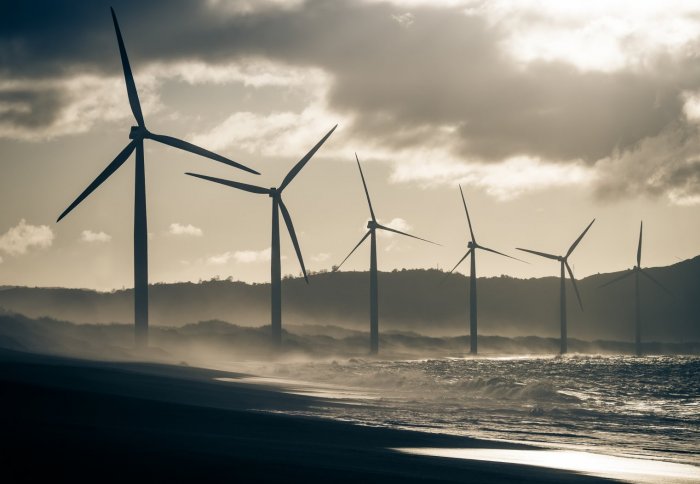European cooperation could provide more stable wind power

Europe could make much better use of its wind resources if capacity was spread out instead of being concentrated around the North Sea.
This is the conclusion reached by a group of energy and climate researchers at ETH Zürich and Imperial College London, who for the first time have combined a long-term analysis of predominant weather patterns with Europe-wide wind electricity generation data.
Countries such as Greece could act as a valuable counterbalance to Europe’s current wind farms.
– Dr Iain Staffell
One of the main criticisms of renewable energy is its intermittency: turbines only produce energy when it is windy, and solar panels only do when the sun shines. This makes it difficult to rely heavily on renewable power, as output fluctuates a lot with weather.
However, the new study, published today in Nature Climate Change, shows that if European countries cooperated better in the field of wind energy instead of relying heavily on specific countries with generous subsidies, wind power production across the continent would be more stable.
For example, Greece and the Balkans can experience as much wind as northwest Europe, but poorer access to finance means the region has only developed a tenth as much wind power as Germany alone.
Europe’s weather regimes
The researchers conducted their study by combining Europe-wide data on large-scale weather conditions from the past 30 years with wind and solar electricity production data. This made use of the Renewables.ninja platform developed by Imperial and ETH Zürich for simulating the output of Europe’s wind and solar farms based on NASA data.
The researchers used this data to model how wind power production is related to seven prevailing ‘weather regimes’ in Europe and how some of the regimes create contrasting conditions in the east and west of the continent.
Study co-author Dr Iain Staffell, from the Centre for Environmental Policy at Imperial, said: “Some weather regimes are characterised by storms rolling in from the Atlantic bringing high winds to northwest or southwest Europe, but these are accompanied by calm conditions in the east.
“Other regimes see calmer weather from the Atlantic and a huge drop in wind production in Germany, the British Isles and Spain. But at the same time, wind speeds consistently increase in southeast Europe, and this is why countries such as Greece could act as a valuable counterbalance to Europe’s current wind farms.”
Today’s wind farms are heavily concentrated in countries bordering the North Sea. This results in uneven wind electricity generation, because most capacity is installed in neighbouring countries with similar weather conditions. A further concentration of capacity in the North Sea region is planned in the near future, which will exacerbate the problems for Europe’s power system, say the researchers.
Cooperation would compensate for fluctuations
The study reveals that if European countries were to cooperate and set up future wind farms based on understanding of the continent-scale weather regimes, fluctuations in future wind energy could be reduced
Adopting the new knowledge would require a paradigm shift in the planning strategies of countries with wind power potential and more European collaboration.
– Dr Christian Grams
For example, the planned development around the North Sea means 100 GW (100 large power stations) would need to be turned on or off to balance out changes in wind power production when the weather changes. With a more cooperatively designed system, this could be reduced to just 20 GW across the continent.
The Balkans, Greece, the western Mediterranean and northern Scandinavia are all potential sites for balancing. Lead author of the study Dr Christian Grams from ETH said: “Adopting the new knowledge would require a paradigm shift in the planning strategies of countries with wind power potential and more European collaboration.”
The researchers say that energy storage technologies, or other renewable energies, would not by themselves be able to close the wind capacity gap, and that distributed wind power is the best option. Current storage technologies are more suited to compensating for shorter fluctuations of a few hours or days, and in order for solar pick up the slack, solar energy capacity would have to be increased tenfold.
Co-author Dr Stefan Pfenninger from ETH said: “The sun often shines when it’s calm, but in winter there is often not enough sunshine in central and northern Europe to produce sufficient electricity using solar panels.”
The researchers now hope that wind farm developers and network operators, as well as governments and politicians, will take their new findings into account in Europe-wide planning and grid expansion.
-
'Balancing Europe’s wind power output through spatial deployment informed by weather regimes' by Christian M. Grams, Remo Beerli, Stefan Pfenninger, Iain Staffell and Heini Wernli is published in Nature Climate Change.
Article text (excluding photos or graphics) © Imperial College London.
Photos and graphics subject to third party copyright used with permission or © Imperial College London.
Reporter
Hayley Dunning
Communications Division